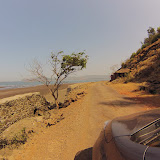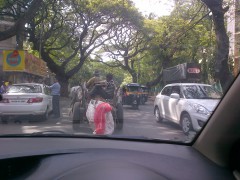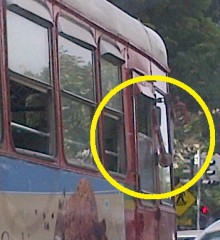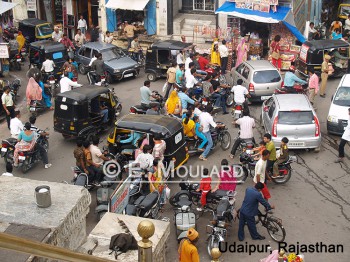Search : cow
Tir(ing) stories
For those who follow, I have been driving since June.
I have become expert in overtaking these bloody cycle-rickshaws but I still get a shock when the car in front of me suddenly pulls out and I find myself face to face with a cow, or a zebu, quite numerous in my industrial area.
My car is my freedom. I love it. I love driving. But more than that, it was quite necessary in such a big and spread city as Delhi. Here you get space (compared to Mumbai) but the price for it is that there are not too many things at leg’s reach.
But my car has also brought its share of hassles. Firstly you need to wash it every day otherwise you don’t recognize it. For instance, I have not been washing the roof of it for some time and it looks like it is wearing a white wig. Classy… Obviously, no one washes their car themselves – for 8 euros (500 rupees), anyone can do it for you. But I haven’t taken the time to look for someone and beside I like this intimate moment with my car. Except that it usually happens that I am in a rush and well-dressed when I have to wash it…
Small other hassles are there, like when an asshole flattens your tires regularly… The first time it happened, I didn’t realize I had a flat tire. A colleague of mine had to tell me. Alright, I had realized that there was something wrong, could just not figure out what exactly. So what do you do with a punctured tire in India huh?? Since I am a girl and quite tired, I would have liked to sit and cry like if the world had collapsed.
But a colleague of mine and our watchman took care of it and changed the tire. Then I went to the petrol pump but they didn’t deal in tires. They told me about a place that seemed very far – no change I would ever find it. So I listened to my conscience and went to the petrol pump next door. And here he was, the tire walla!
I was a bit ashamed to see a twelve year old change my tire in the dark night but he did it very well! It’s okay if I am not good at everything… He could not find a puncture and put back the tire. All this for 30 rupees (less than half a euro).
The next morning, the other tire was flat. I just went back to the tire shop and he took care of it. I go back regularly since I haven’t found out who does this…
And the best part of the story is that I take things with philosophy. I think six years ago, I would have blown a fuse and made a big scandal in the neighborhood. Now I just go to the tire walla…
11/24/2012 | Permalink
Searching for the lost turtle...
When Indians ask for a leave, they always give you an explanation; this is pretty funny... They have to attend the naming ceremony of a newborn, take their wife to get an MRI of her arm etc. That’s how, one fine day (it was a Wednesday I remember), one of my direct reports asked me if he could take a day off to... go see turtles hatching! Turtles!! Not only did I give him a day off and my blessings, I also tagged along!
We left Mumbai early (very early), towards the village of Velas on the Konkan coast of Maharashtra. Very quickly a foul odor – which had already disturbed us a few weeks earlier – spread in the car. Incredibly brave, my favorite Indian opened the bonnet and discovered the corpse of a cat. As it was early (very early), he took the bull by the horns (or rather the cat by the legs) and removed it himself – ignoring my advice of delegating the task to any guy against twenty rupees...
Later on we found a place to clean the car but the pressure washer hardly helped, death smell is tenacious. So I spent a good amount of the journey playing with incense stick, to the tune of One Republic: 
Seven hours later, we arrived in Velas, a village blessed with no network coverage (in brief, a village like I like them!). Our local guide had set sail for Mumbai without informing anyone and our small group found refuge in a random house, where we tried to call him (with a landline). An hour later we finally touched base with our host cum lunch provider.
After a micro-siesta we were off to the beach to meet the turtles!
A beautiful beach, without a human soul nor a... turtle! We learned then that the turtles come to lay their eggs at night only and the NGO involved in their preservation doesn’t let people walk on the beach at night to avoid disturbing them – annoying but fair... Anyway, we were also told that the previous night, only one turtle (according to fin prints) had visited the premises. Plus at night it was so pitch dark that the chances to spot that brave turtle were close to nothing! Still we woke up at 5 AM the next morning to go track down turtle prints – who knows?? Well we do now… Luck was not with us!!
As for eggs hatching, well, let’s say it wasn’t the right period...
Nevertheless, we saw a turtle! A river turtle (or tortoise) caught by a fisherman...
But we didn’t come home empty-handed since we got the information that it is on the beaches of Orissa (on the other side of the country) that turtles come by the thousands to nest...
And we could witness the work that an NGO can make by empowering local communities in the preservation of endangered species: stop hunting turtles, protect the eggs from predators, and take on the path of turtle tourism, becoming a "turtle village" with a "turtle festival" (website). Quite smart! There is just a bit of work so that tourists can actually see turtles. Or so that white-bellied Eagles spend a little more time in their nest and tourists can see them also!
Anyway, we spent a great weekend in the countryside! In a very quiet village with old-style houses, their floors covered with cow dung to prevent vermin, with cats in every house (which is pretty rare in India) to give warning of ophidian intrusions, with skinny chickens everywhere. We slept at a home-stay: very simple (very thin mattresses on the floor, Indian toilet in the garden (or more exactly in the palm grove behind the house) but clean!
The road from Mumbai is beautiful, especially when you leave the highway (well, the highway... the word is big) and the road gets empty...
And then we managed to defeat the dead cat smell by taking in a hitchhiking India: he was a Pandit (priest) who had come to perform a puja for a baby whose stars were not a birth (especially Venus) and who smelled of wood fire!
 |
| Velas, Maharashtra - Feb 2014 |
04/12/2014 | Permalink
Incredible Iceland!
For the year-end holidays, my family and I flew to an exotic (but not paradisiac) destination, chosen with care to be nothing like India. Here you go: Iceland! A country where it is good to breathe pure air. Or so I thought.
Upon arrival at our hotel we were engulfed in a poignant smell of fish which was not unlike what I could get in Khar, an area of Mumbai (with its fishing villages where they put up fish for drying) at its most fragrant hours. Consternation. None of us dared suggest to change the hotel – anyway all (absolutely all) the hotels are full in this season – and it was a good call because it was actually a unique day, the day before Christmas Eve, the only day of the year where Icelanders prepare a particularly tasty delicacy: fermented ray!
A few days later, our guide joined us at the hotel in the morning, with an empty tank. Indian ,get out of this body! Because it is something that drivers love here: put gas at the last minute! But this guy was even better: despite a 12-hour storm, he had not put the right tires and of course, we got stuck in the snow.
We met few Icelandic people (I must say that they are not many of them, with only 320 000 souls) but what I was told and what I could read about them really made me smile: completely family oriented (in the (very) broad sense of the term), a homebird attitude and a real attachment to the motherland, no driving rules, mixed up prononciation of v and w, a zen attitude and tendency to do everything at the last minute. Doesn’t it remind of someone?!
But the similarity ends there. Physically to start with: pale hulks with blue eyes versus chocolate (with the whole range of colours) weaklings with dark eyes. Underpopulation versus urban overpopulation (there are something like 4,000 times more Indians!). A certain sexual freedom versus a certain conservatism. An island versus a subcontinent. And then a major difference: the number of Asian tourists by square meter.
I am ashamed to say that I knew nothing of Iceland before going there. So when I saw a lot of people with slanting waiting in the queue for our flight at Paris airport I asked my favourite Indian if they were not Icelandic natives. Something like the Inuit you see? Well, little did I know that Iceland has in fact been populated by the Norwegians Vikings starting in 871. Before there was nothing. No Inuit. Just bears and polar foxes. The Vikings brought the horses, the goats (there are 3 lambs for each Icelander) and cows (which curiously have not mutated to become angora (unlike the horses) and therefore have to be kept inside during the winter because there the wind is so strong it could blow off the horns of the oxen, and it is not just an expression; it does clean your lungs!).
To get back to tourism, in 2015, Iceland received about 1.3 million visitors, of which 48,000 came from China and it probably doubled in 2016. It is only 4% but tourism figures actually include all the travelers arriving at the airport and Reykjavik has become a kind of hub for flights to the United States (which, with the United Kingdom account for 40% of the tourists). Also, apparently, Chinese like visiting Iceland in winter.
Iceland it was. A rough country where nature is queen. Where all the elements meet, air fire water, in their full power. It puts your ideas back in place, and it is splendid.
PS: Icelanders are very good at marketing, really creative, at least with regard to the promotion of their country. They sell you the northern lights like no other. But it’s a bit like the tiger in India, you go on safari searching for the Grail for hours and it is far from guaranteed ;) So better go in Iceland for anything else than the sky!
Some photos here
01/30/2017 | Permalink | Comments (1)
Why in India it's the jungle on the roads?
 I drove my four colleagues to the restaurant the other day. One of them appreciated my driving style by passing the following comment: “If a cop stopped you he would immediately give you the Indian nationality!” Understand that, in ten minutes, I had honked enough and went through enough red lights to be called an Indian!
I drove my four colleagues to the restaurant the other day. One of them appreciated my driving style by passing the following comment: “If a cop stopped you he would immediately give you the Indian nationality!” Understand that, in ten minutes, I had honked enough and went through enough red lights to be called an Indian!
But then, why do Indians drive so bad?
I stop you immediately, it is not because of women! In 2011, only 11% of the driving licenses belonged to women (1); and most of them don’t even drive...
It's a combination of factors that explains the anarchy that reigns on the roads in India...
There are not enough roads (even if the road network is the second worldwide in terms of kilometres and increases from 4% per year since 1951) (2); and especially they are horrible! And I am not talking about the roads of Madhya Pradesh (where it takes 10 hours to cover 500 kms); Mumbai (the economic capital) asphalt has more holes than the gruyère!
The number of drivers increases super-fast, a few dozen millions every year.
And the practice of driving is relatively new: in one generation (20 years) the number of vehicles on the roads has gone up from 5 to 142 million! And yet... barely 1% of Indians own a car. (3) Scary! (except perhaps for the automakers...)
 Most people use public transport (90% of it being the bus) or auto-rickshaws. But bus drivers are the mentally challenged: they do not stop under any circumstance (not even to load passengers). Mumbai bus drivers even operate manually their turning signal – a steel arrow placed on the front windows. When they operate it. Most the vehicles date back to Methuselah and they often carry 2 to 3 times the number of scheduled passengers. Hence tens of thousands of victims of the public transport in India every year... (4)
Most people use public transport (90% of it being the bus) or auto-rickshaws. But bus drivers are the mentally challenged: they do not stop under any circumstance (not even to load passengers). Mumbai bus drivers even operate manually their turning signal – a steel arrow placed on the front windows. When they operate it. Most the vehicles date back to Methuselah and they often carry 2 to 3 times the number of scheduled passengers. Hence tens of thousands of victims of the public transport in India every year... (4)
To top it off, most Indians got their license in a lucky bag or somethin! Technically, when you apply, they give you a temporary license and to get the final license you have to pass a driving test (driving lessons are not compulsory however). I did a round table and three of my four colleagues have not given the exam... You can buy everything in India! As a result, most Indians seem to ignore the difference between high and low beam headlights and you can get totally blinded when you drive at night in a city (especially in Delhi)...
I found an online test to check if you know the driving ; thereregulations are only a dozen simple questions (5). I did it, and then I went on to search for the driving rules in India (6). There are just 30: keep left; drive on the left side when planning to turn left; drive on the right side when planning to turn right; pass to the right (unless the vehicle before you has stopped to turn right); slow down when arriving at an intersection or a crosswalk, when entering a road interjection, if the road entered is a main road designated as such, give way to the vehicles proceeding along the road, and in any other case give way to all traffic approaching to the intersection on his right hand; do not u-turn when it is prohibited; stop for pedestrians; give free passage to ambulances; do no drive a vehicle in a reverse direction into a road designated ‘One Way’; stop at the signal and the police officer who controls traffic. And that’s pretty much it!
simple questions (5). I did it, and then I went on to search for the driving rules in India (6). There are just 30: keep left; drive on the left side when planning to turn left; drive on the right side when planning to turn right; pass to the right (unless the vehicle before you has stopped to turn right); slow down when arriving at an intersection or a crosswalk, when entering a road interjection, if the road entered is a main road designated as such, give way to the vehicles proceeding along the road, and in any other case give way to all traffic approaching to the intersection on his right hand; do not u-turn when it is prohibited; stop for pedestrians; give free passage to ambulances; do no drive a vehicle in a reverse direction into a road designated ‘One Way’; stop at the signal and the police officer who controls traffic. And that’s pretty much it!
Except on it comes to signals! Judge by yourself: "When about to slow down, extend the right arm with the palm downward; when about to stop, raise the right forearm vertically outside, palm to the right; when about to turn to the right, extend the right hand in a horizontal position outside with the palm of the hand turned to the front; when about to turn to the left, extend the right arm and rotate it in an anticlockwise direction; when about to overtake, extend the right hand and arm horizontally outside and bring the arm backward and forward in a semi- circular motion. The signals referred above may be simplified also by mechanical or electrical devices."
To conclude, the most important rule (which is not written) is: look straight and drive! The others will manage to avoid you, no problem...
Let us not forget the hyper-individualistic behaviour of Indians in certain circumstances (apparently inherited from the time of protectionism, rationing and shortages, where the Indians had to fight, literally, to have access to any consumption good (food, radio, clothes etc.). Behaviour you can come across when waiting in a line or… driving!
And above all I would like to highlight that cars are not the only ones who have the right to use the roads... Cows, goats, bullock-carts, tractors, horses also have a right of way.
Mix all that and you get chaos on the roads! And obviously there are a lot of accidents and many more lethal ones that one might imagine given the slow speed of driving... (7)
(1) Source: http://articles.timesofindia.indiatimes.com/2012-03-08/chennai/31135711_1_women-friendly-licences-motorcycle-manufacturers
(2) If the India has the second road network in the world with 4.2 million kilometers which grows 4% annually since 1951 (3.4% since 2001), it's still a growth over half the number of cars. Source: http://www.indiaspend.com/investigations/indias-traffic-n...
(3) 0.3 million vehicles in 1951, 5.4 million in 1981, 21.4 million in 1991, 55 million in 2001 and 142 million in 2011!
Sources: http://nctr.USF.edu/JPT/PDF/JPT%208-1%20Singh.PDF http://data.gov.in/dataset/state-wise-total-registered-mo...
Review of Urban Transportation in India: http://nctr.USF.edu/JPT/PDF/JPT%208-1%20Singh.PDF
The Indian fleet is almost five times that of France (with 142 million vehicles on Indian roads in 2011 against 31 million in France). Obviously if reported number of inhabitants the France has 4 times more vehicles per 1,000 inhabitants (481 against 118).
Sources: http://www.statistiques-mondiales.com/ue_voitures.htm; http://www.knowindia.NET/auto.html ; http://www.linternaute.com/auto/magazine/l-automobile-en-10-CHIFFRES-CLES/31-millions.shtml
(4) The bus represents 90% of public transportation in India – a trend shared all across the country except in Mumbai where trains carry 58% of the people who use public transport. In Delhi and Chennai less than half the people use public transportation. A trend opposed to Mumbai or Kolkata – which is due to the configuration of the cities (the first ones are less densely populated, more polycentric and geographically spread). The Delhi metro is superb but already crowded (especially at peak hours) and not practical: its star structure requires to always go back to the heart of the city to change lines. Bangalore and Kolkata also have the metro and it is under process in many other cities.
Sources: http://cistup.IISc.ernet.in/urban%20Mobility%208th%20March%202012/crisis%20Of%20public%20transport%20in%20India.PDF ; http://economictimes.Indiatimes.com/slideshows/infrastructure/ten-metro-rail-projects-transforming-Indian-cities/Kochi-Metro/slideshow/21478253.CMS
(5) http://rtoindia.com/startTest.asp
(6) http://auto.indiamart.com/user-manual/road-regulation.html
(7) http://www.indiansamourai.com/archive/2009/08/18/-.html
10/20/2013 | Permalink | Comments (1)















![IMG_7900[1].JPG](http://www.indiansamourai.com/media/00/01/1826088272.JPG)
